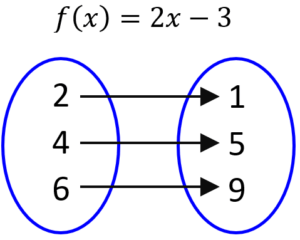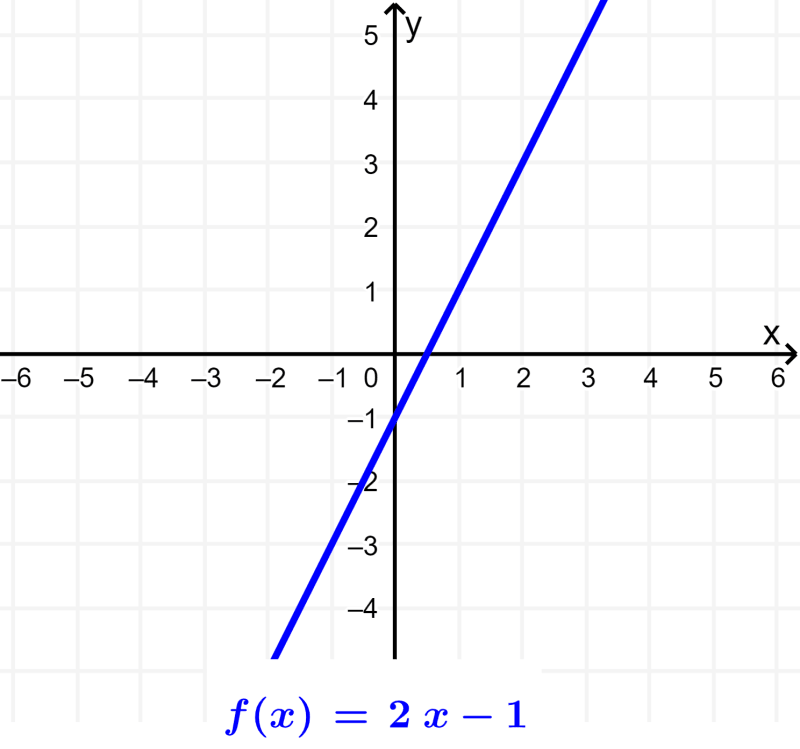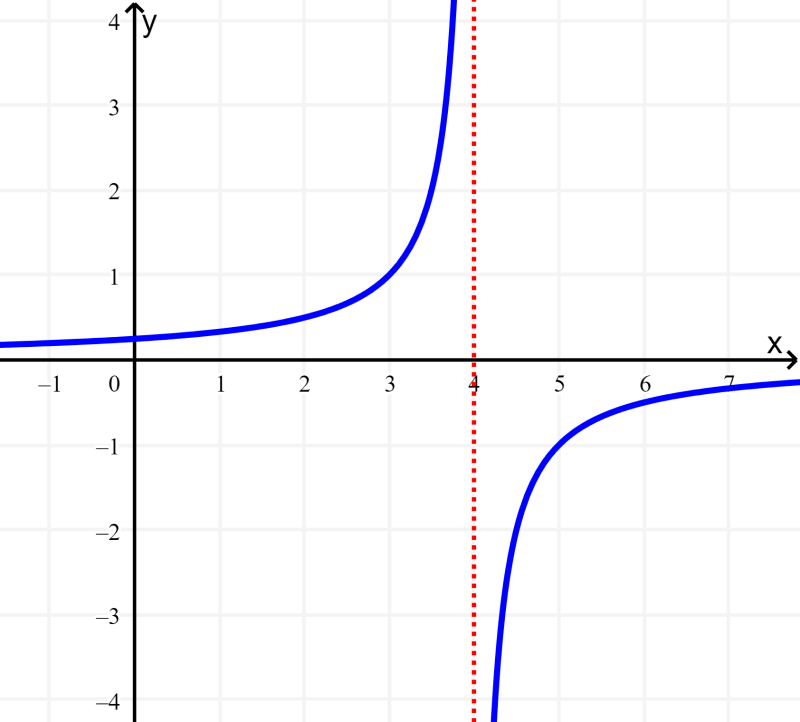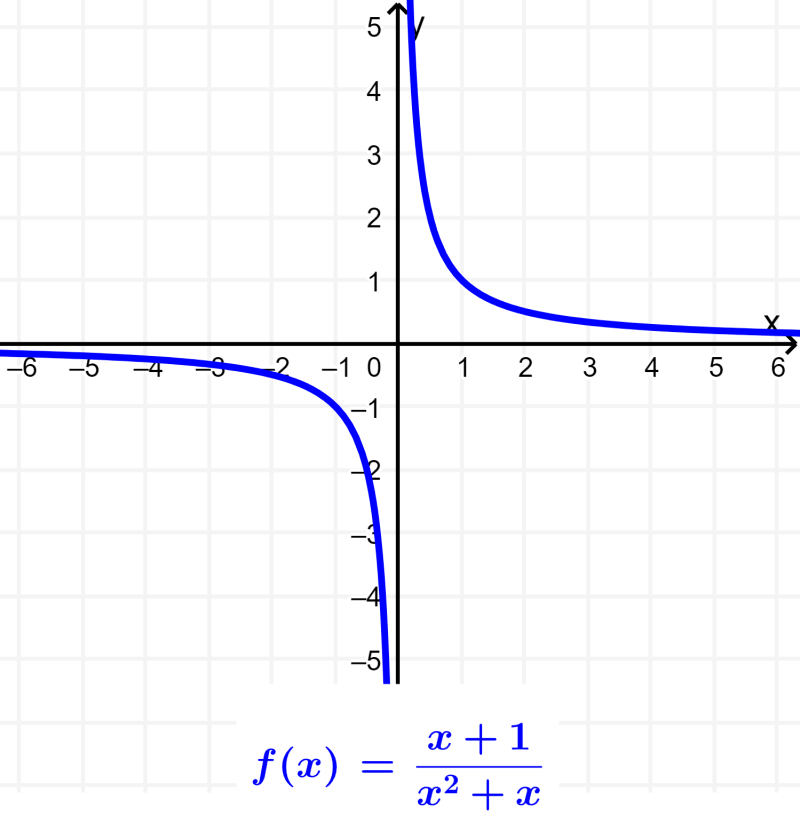In this article, we will learn how to find the domain and range of a rational function either by using its graph or by using definite algebraic rules. We will start by doing a brief review of what domain and range mean.
Then, we will look at the methods used to find the domain and range of rational functions. Finally, we will look at some examples with answers that illustrate the use of these methods.
What is the domain and range of functions?
If we think of a function as a mapping diagram that relates an input to an output, the domain would be the set of inputs and the range would be the set of outputs. Let’s consider the following mapping diagram:

We can see the inputs on the left and the outputs on the right. Here, the domain is the set {2, 4, 6} and the range is the set {1, 5, 9}. If we consider the function $latex f(x)= 2x-3$ with the domain {1, 2, 3, 4}, we can find the range by substituting each of the domain values in the function:
$latex f(1)=2(1)-3=-1$
$latex f(2)=2(2)-3=1$
$latex f(3)=2(3)-3=3$
$latex f(4)=2(4)-3=9$
Therefore, the range is the set {-1, 1, 3, 9}.
Now, let’s consider the function $latex f(x)=2x-1$ with domain $latex x \in R$ (it means that x belongs to the set of all real numbers). It may be helpful to look at your graph to make it easier to determine the range:

We can see that the graph is a straight line and every real input has a real output, and since the line continues towards positive and negative infinity, any real number of output is possible. Thus, the range is all real numbers.
If we now look at the quadratic function $latex f(x)={{x}^2}$, which has a domain that is all real numbers. We can look at its graph to determine the range:

We see that for each input, the output is always positive. Therefore, the range of the function is equal to all real numbers greater than or equal to zero.
How to find the domain and range of rational functions?
Generally, we tend to define the domain and range of functions on real numbers, so we will do the same here. However, we will use different strategies to find the domain and range of rational functions since obtaining the graphs of these functions is not very easy. Let’s consider the following rational function:
$latex f(x)= \frac{3}{x + 2}$
We observe that, for the input of -2, we obtain an output of $latex \frac{3}{0}$.
We know that division by zero is undefined, so the function is undefined at this point. However, any other input will have a real number output, so we conclude that the domain is all real numbers excluding -2. We can write this as:
$latex R- \{- 2\}$
By considering the nature of the function, we can see that any real number of outputs can be achieved with the exception of zero. This is because as x gets larger in magnitude, the output gets smaller, but the output can never equal zero. Therefore, the range of the function is:
$latex R – \{0 \}$
In general, we can calculate the domain of a rational function by identifying any point where the function is undefined. This means finding any point that makes the denominator equal to zero.
To find the range of a rational function, we can identify any point that cannot be reached with any input. This is generally found by considering the limits of the function as the magnitude of the inputs gets larger.
Examples of domain and range of rational functions
The following examples illustrate the concepts detailed above.
EXAMPLE 1
Find the domain and range of the function $latex f(x) = – \frac{1}{x-4}$.

Solution: Looking at the graph, it appears that the domain is $latex R – \{4 \}$ and the range is $latex R – \{0 \}$. However, let’s check this algebraically.
We know that a function is undefined for inputs that result in denominators equal to zero. We can form an equation with the denominator to find the undefined point:
$latex x-4 = 0$
$latex x = 4$
This confirms that the domain is $latex R – \{4 \}$. To confirm the range, we have to identify the values that cannot be reached with the given domain. As x gets larger, the output tends to zero, but never becomes zero. Therefore, the range is $latex R – \{0 \}$.
EXAMPLE 2
Find the domain and range of the function $latex f(x)= \frac{1}{x-10}$.
Solution: In this case we do not have a graph, so we have to solve the problem algebraically.
Again, we know that the expression $latex \frac{1}{0}$ is undefined, so we form an equation with the denominator to find the undefined point:
$latex x-10=0$
$latex x = 10$
Therefore, we know that the domain of the function is $latex R- \{10 \}$. To identify the range, we have to identify the values that cannot be reached with the given domain. As x gets larger, the output tends to zero, but never becomes zero. Therefore, the range is $latex R – \{0 \}$.
EXAMPLE 3
Find the domain of the function $latex f(x)= \frac{3}{x-3} + \frac{1}{x+4}$.
Solution: We know that rational functions are only defined when their denominator is different from zero. In this function, we can see that there are two points for which it is not defined: when $latex x-3 = 0$ and when $latex x+4 = 0$.
This means that the function is undefined when $latex x = -4$ and $latex x = 3$. Therefore, the domain of the function is all real numbers except -4 and 3, denoted $latex R – \{- 4, 3 \}$.
If we wanted to find the range of this function, despite the fact that each of the rational expressions cannot take a value of zero, there is an input of x that results in zero, which is $latex x = – \frac{9 }{4}$. Therefore, the range of the function is all real numbers (R).
EXAMPLE 4
Determine the domain of the function $latex f(x)= \frac{{{x}^2}+5}{5{{x}^3}+ 50x}$.
Solution: We remember that rational functions are only defined when their denominator is different from zero. Therefore, to find the domain of the function, we have to find the zeros of the equation in the denominator:
$latex 5{{x}^3}+50x=0$
We can factor the x:
$latex x(5{{x}^2}+50)=0$
We can see that we have a zero when $latex x=0$. However, the quadratic $latex 5{{x}^2}+50$ has no real roots. Therefore, the only zero in the denominator is $latex x=0$. The domain is all real numbers except zero, denoted $latex R- \{0 \}$.
See also
Interested in learning more about the domain and range of functions? Take a look at these pages:




